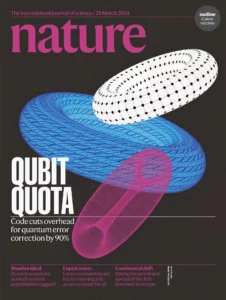IBM Reports 10 Times More Efficient Error-Correcting Method Brings Practical Quantum Computers Closer to Reality

Insider Brief
- IBM scientists report in Nature that a new quantum error-correction code is 10 times more efficient than previous methods.
- They add that this method — called the Gröss code — brings quantum computing for practical purposes. one step closer.
- Critical Quote: “Using the Gröss code, you can protect 12 logical qubits for roughly a million cycles of error checks using 288 qubits.”
IBM scientists report they are one step closer to overcoming a stubborn obstacle to unlock the game-changing potential of quantum computers.
In a paper published Thursday (March 27) as the cover story in the journal Nature, IBM researchers describe a new quantum error-correcting code that is roughly 10 times more efficient than previous methods at protecting delicate quantum data from accumulating errors.
“While quantum error correction theory dates back three decades, theoretical error correction techniques capable of running valuable quantum circuits on real hardware have been too impractical to deploy on quantum systems,” the researchers write in the company blog. “In our new paper, we introduce a new code, which we call the Gröss code, that overcomes that limitation.”
Quantum computers exploit the bizarre laws of quantum mechanics to perform calculations in ways that are different from classical computers. Theoretically, this could allow capabilities — including both positive and negative capabilities like easily cracking modern encryption codes or optimizing drug discovery.
But a major hurdle has been errors creeping into quantum calculations. Quantum data is extremely fragile and can become corrupted by minor disturbances like heat, vibrations, or stray electromagnetic fields.
“Quantum information is fragile and susceptible to noise — environmental noise, noise from the control electronics, hardware imperfections, state preparation and measurement errors, and more,” according to the blog. “In order to run quantum circuits with millions to billions of gates, quantum error correction will be required.”
Scientists have been desperately coming up with error-correction schemes as work-arounds to this obstacle. Error correction works by spreading the fragile quantum data across many physical qubits (the fundamental units of quantum information), allowing it to remain intact even if some qubits become corrupted. However, previous quantum error-correcting codes required a huge overhead of extra qubits, making large-scale error correction impractical.
“Error correction requires that we encode quantum information into more qubits than we would otherwise need,” the blog states. “However, achieving quantum error correction in a scalable and fault-tolerant way has, to this point, been out of reach without considering scales of one million or more physical qubits.”
The leading “surface code” approach illustrates the problem. “Doing roughly the same task with the surface code would require nearly 3,000 qubits,” according to IBM’s analysis.
 But the new Gröss code is far more efficient. “Using the Gröss code, you can protect 12 logical qubits for roughly a million cycles of error checks using 288 qubits,” the blog states.
But the new Gröss code is far more efficient. “Using the Gröss code, you can protect 12 logical qubits for roughly a million cycles of error checks using 288 qubits,” the blog states.
By dramatically reducing the overhead required for error correction, the researchers say the Gröss code clears a major hurdle toward building practical, large-scale quantum computers.
“Our new result published today greatly reduces that overhead, and shows that error correction is within reach,” according to the IBM post.
This milestone is a crucial step on the path to unlocking the full potential of quantum computing across fields like chemistry, optimization, artificial intelligence, and more.
“Over the next few years, we expect to find speedups over classical computing and extract business value from these systems,” the blog states. “But there are also algorithms with mathematically proven speedups over leading classical methods that require tuning quantum circuits with hundreds of millions, to billions, of gates.”
It continues: “While error correction is not a solved problem, this new code makes clear the path toward running quantum circuits with a billion gates or more on our superconducting transmon qubit hardware.”
The researchers acknowledge more work lies ahead to refine their error-correction approach and integrate it into quantum computing systems and algorithms.
“We are still looking for codes with even more efficient architectures, and our research on performing error-corrected calculations using these codes is ongoing,” according to the blog. “But with this publication, the future of error correction looks bright.”
After decades of pursuing the vision of powerful quantum computers, IBM’s breakthrough brings that dream a significant step closer to reality.
“This code is part of our broader strategy to bring useful quantum computing to the world,” the company stated.
For more information and for an in-depth review of both the work and the IBM scientists’ interpretation of their work, we encourage you to read the company blog post here and the Nature paper here.
